When someone loses a leg, walking again becomes more than just a goal — it becomes a journey. And on that journey, the kind of prosthetic they use makes all the difference. Two of the most common types of lower limb prosthetics are transfemoral (above-knee) and transtibial (below-knee). They may seem similar at first glance, but the challenges they present — especially when it comes to bearing weight — are very different.
At Robobionics, we work closely with people using both types of prosthetics every day. We see the hidden struggles, the quiet triumphs, and the questions that often go unanswered. One of the biggest and most common questions is: why does standing, walking, or even just putting pressure on the prosthetic feel so different between the two types?
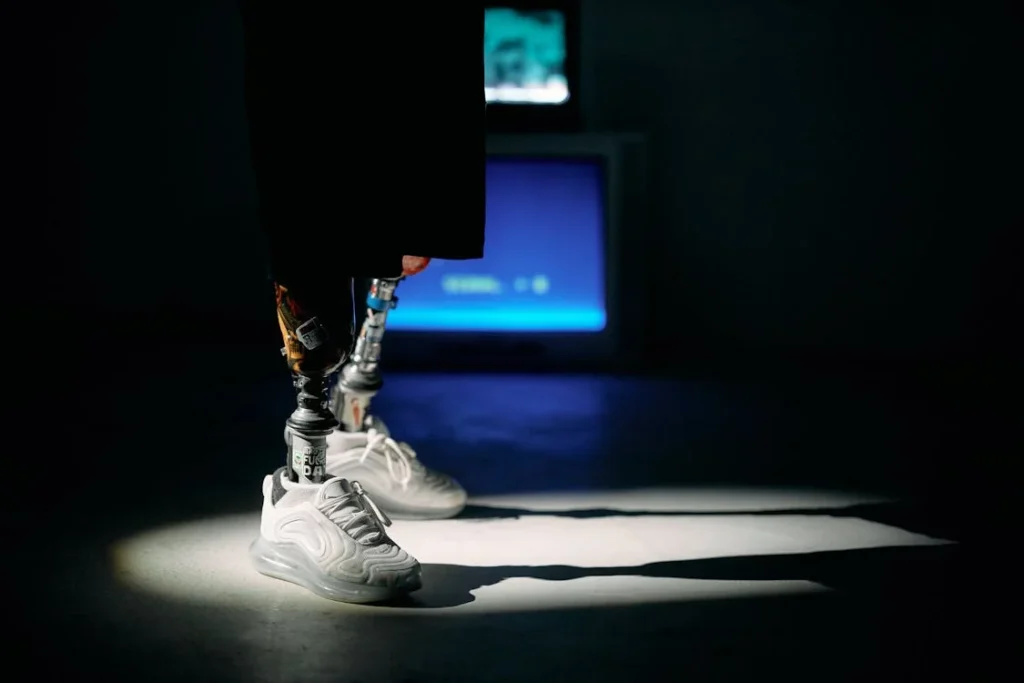
Understanding the Basics of Transfemoral and Transtibial Prosthetics
Before we talk about the challenges, it’s important to understand what each type of prosthetic involves. Every detail matters when it comes to how weight is carried and managed by the body and the device.
What Is a Transtibial Prosthetic?
A transtibial prosthetic is used when the lower leg, below the knee, is amputated. In this case, the person still has their knee joint.
This is important because the knee plays a huge role in walking, balance, and absorbing shock when you take a step. Since the knee is still present and working, transtibial users generally have more natural control over the leg.
The prosthetic limb attaches to the remaining part of the lower leg, called the residual limb. This part fits into a socket, which is custom-made for each person.
The socket is then connected to a foot component. Because the user can bend their knee normally, they often find walking smoother and more stable.
However, that doesn’t mean there are no weight-bearing issues. The socket must be just right, the fit must be snug but not painful, and the skin must stay healthy.
Pressure on the residual limb is a constant issue, especially during long walks or standing for long periods.
What Is a Transfemoral Prosthetic?
A transfemoral prosthetic is used when the amputation is above the knee. That means the entire knee joint is gone. The person now depends on a mechanical or robotic knee to move, bend, and support them.
This makes walking a very different process. The person must now think about every movement their prosthetic leg makes. The thigh muscles have to work harder, and balance becomes a bigger challenge.
The socket attaches much higher, and the weight is spread over a larger area — usually the thigh and hip.
Weight-bearing here is more difficult because the knee is no longer available to help. Instead, all the pressure from walking shifts into the upper leg and hip area, and often into the lower back as well.
The prosthetic must compensate for the missing knee, which is not an easy task.
Why the Difference in Weight Distribution Matters
Think about how your legs work when you take a step. Your foot hits the ground, your knee bends slightly, your muscles absorb the impact, and your hips help move you forward. Now take away the knee — or take away part of the lower leg — and everything shifts.
In transtibial users, most of the body weight is still handled by the lower leg muscles and the knee. But in transfemoral users, the work shifts to the hip and pelvis.
The artificial knee can help, but it will never match the power and reflexes of a natural knee. So the person has to work harder to stay balanced and upright.
It also means the risk of falling or tripping can be higher. The person may have to think consciously about every step, especially when walking on uneven ground, going up stairs, or standing for long periods.
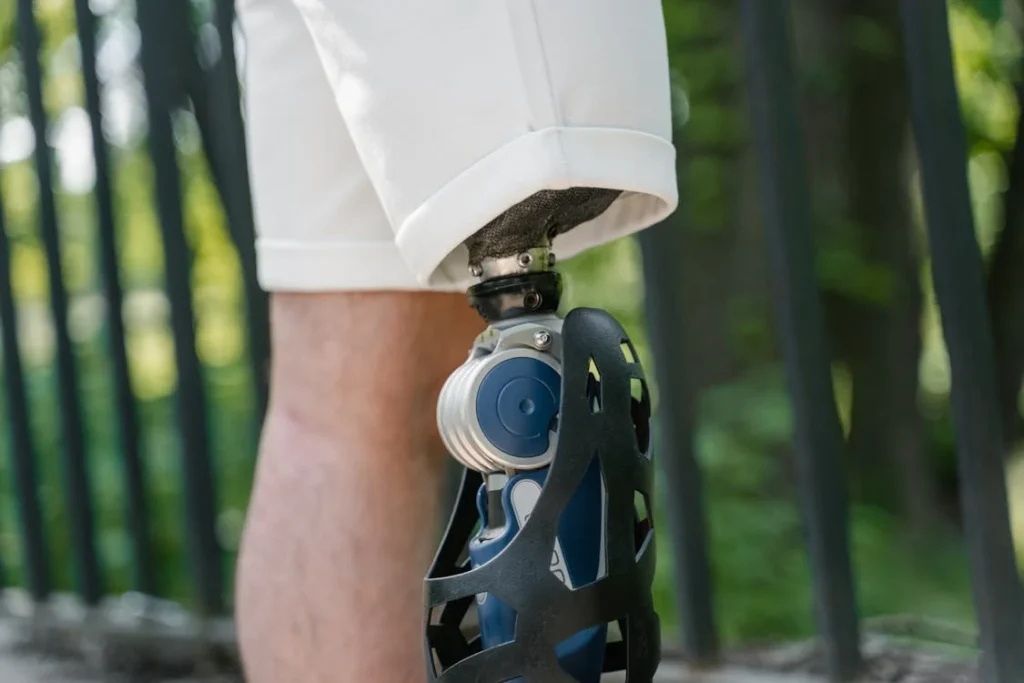
The Mechanics of Weight-Bearing in Everyday Life
To understand the weight-bearing challenges more deeply, we need to look at how these prosthetics function during simple, daily tasks — like standing up from a chair, walking across a room, or climbing stairs.
These might seem small, but for someone using a prosthetic leg, each one comes with unique effort and planning.
Standing and Balancing
For transtibial users, standing is relatively more stable because their own knee can lock and adjust naturally to balance changes.
The pressure is mostly felt in the lower part of the leg, especially around the shin and calf. If the socket is well-fitted, standing feels almost normal after enough practice and rehab.
Transfemoral users, on the other hand, face more effort when simply trying to stand still. The artificial knee must remain straight and locked to keep the body upright. If the knee buckles or shifts, it can lead to sudden imbalance.
The body compensates by shifting more weight onto the sound limb or using assistive tools like walking sticks or crutches. This extra pressure can cause fatigue and muscle soreness, especially in the hips and lower back.
Walking Patterns and Weight Shifts
Transtibial users can maintain a walking rhythm that is close to natural. Their knee helps absorb shock, and their foot rolls forward in a smoother motion.
However, issues can arise if the socket fits poorly or the residual limb changes shape over time. A poor fit can lead to pain and uneven pressure points, which force the person to limp or walk with hesitation.
Transfemoral users often develop a gait that looks more deliberate or cautious. Since the artificial knee doesn’t “know” when to bend on its own, the user has to trigger it with body motion or rely on a microprocessor inside the knee unit.
This makes walking slower and sometimes tiring. Weight doesn’t flow naturally through the prosthetic leg, so the person often places more weight on their intact leg. Over time, this creates imbalances and pain in the healthy leg or hip.
Climbing Stairs and Slopes
Stairs can be a major challenge. Transtibial users can usually go up and down stairs with support from a railing, because their natural knee allows them to lift and control their body weight step by step. It takes strength, but it’s possible to do with a bit of training.
Transfemoral users often find stairs much harder. Without a natural knee to push off, climbing stairs requires lifting the entire prosthetic leg from the hip. This is called “hip hiking,” and it’s very tiring.
It also increases pressure on the socket and the residual limb. Going down stairs is even harder because the artificial knee must stay stable to avoid sudden buckling. Many users resort to taking stairs one step at a time, leading with the healthy leg.
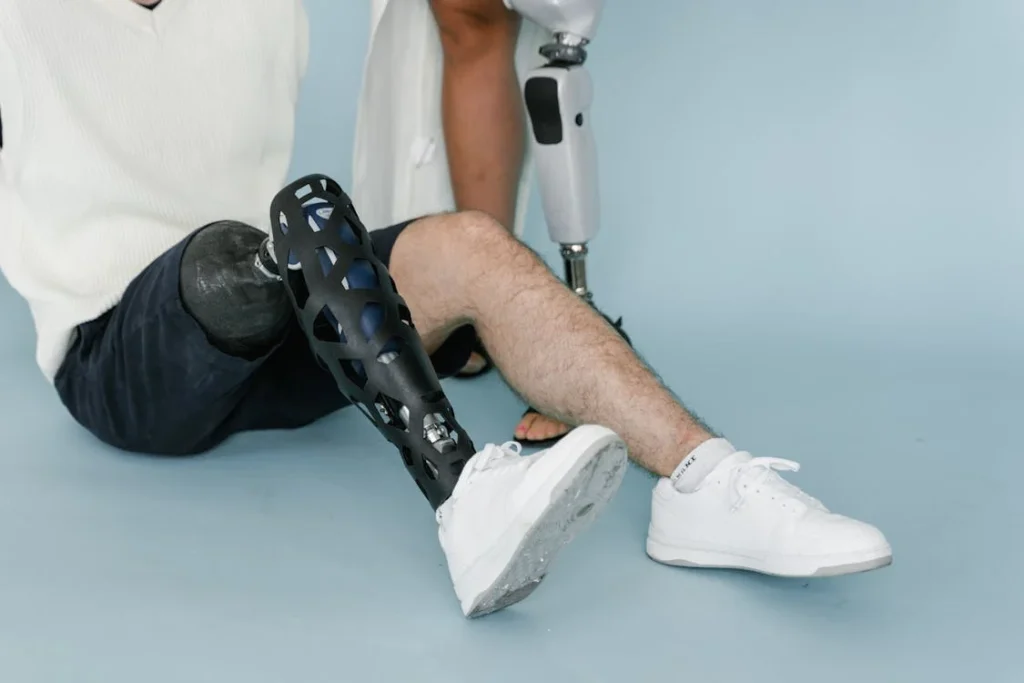
The Role of the Socket in Weight-Bearing Comfort
The socket is the heart of any prosthetic. It’s the part that holds the limb, supports the body’s weight, and transfers movement to the rest of the prosthesis. A small issue in socket fit can lead to a big problem in weight distribution, comfort, and long-term mobility.
For Transtibial Users
Since transtibial users still have a portion of their lower leg, the socket typically fits around the shin area and sometimes a bit above.
The residual limb has muscle and skin that can absorb some of the weight. If the socket is well-aligned, it spreads pressure across the surface evenly.
But if the socket is too loose, too tight, or poorly shaped, it can cause pain around bony areas, bruising, or even skin breakdown.
When this happens, users start to shift their weight to one side to avoid discomfort. This leads to muscle imbalance, uneven walking, and sometimes further injury.
Another common issue is volume fluctuation — the residual limb can swell or shrink slightly throughout the day due to heat, movement, or even food and water intake.
This changes how the socket fits, which can make weight-bearing unpredictable.
Transtibial users usually wear liners made of silicone or gel to cushion the leg and reduce skin problems.
These liners help to distribute weight more softly, but they need to be kept clean and replaced regularly. A worn-out liner can quickly turn into a weight-bearing issue.
For Transfemoral Users
Socket design becomes more complicated when there’s no knee joint. In transfemoral prosthetics, the socket has to hold the thigh securely without causing pain or limiting movement.
The most common types are ischial containment sockets and subischial sockets. These wrap around the pelvis and upper thigh and are meant to keep the limb steady even during motion.
Since the entire weight of the prosthetic leg (and the user’s body) is transmitted through the thigh, pressure builds up much higher than in transtibial sockets.
This can lead to pinching, rubbing, or heat buildup. Many transfemoral users experience skin issues, especially in hot or humid climates.
In India, where summer temperatures can rise dramatically, this becomes a very real problem.
Sweat collects in the socket, the skin gets irritated, and the user becomes hesitant to wear the prosthetic for long hours. That hesitation leads to muscle weakening and slower recovery.
This is why socket fit and design matter even more in transfemoral cases. A well-fit socket can make standing and walking feel strong and stable. A poor one can make every step feel like a struggle.
Energy Expenditure and Muscle Fatigue
Weight-bearing is not just about pressure. It’s also about energy. How much effort does it take to walk across a room? How tired does someone feel after a short outing?
Energy Use in Transtibial Prosthetics
People with below-knee amputations use more energy to walk than someone with both natural legs, but the increase is manageable.
On average, transtibial users use about 10–20% more energy. Most people can adapt to this, especially with physical therapy and regular walking practice.
The knee joint helps conserve energy by supporting movement naturally. So even though the person is using a prosthetic foot, their walking pattern remains close to normal.
Over time, their body adjusts, and the added energy cost becomes less noticeable.
This doesn’t mean there’s no fatigue. If the residual limb is sore, or the person walks with a limp due to socket issues, the extra energy spent can still wear them down by the end of the day.
Energy Use in Transfemoral Prosthetics
Transfemoral users face a very different picture. Without a knee, the body has to work harder to control the artificial limb. Studies show they use around 60–70% more energy than people with natural legs. That’s a huge jump.
The hip muscles become the main engine for walking. Every step involves lifting the entire leg, guiding it forward, and stabilizing it again — all without natural knee reflexes to help. The longer the walk, the heavier the leg feels.
This leads to quicker fatigue, especially for people who are new to using their prosthetic or have other health conditions.
It’s also one reason why many transfemoral users take shorter trips or avoid walking altogether in hot weather or crowded spaces.
The key to reducing this energy drain is proper alignment of the prosthetic, strength training of the core and hip muscles, and using a knee unit that responds quickly to movement.
Some newer microprocessor-controlled knees can adjust in real time and make walking feel smoother — but they can be expensive and require proper training.
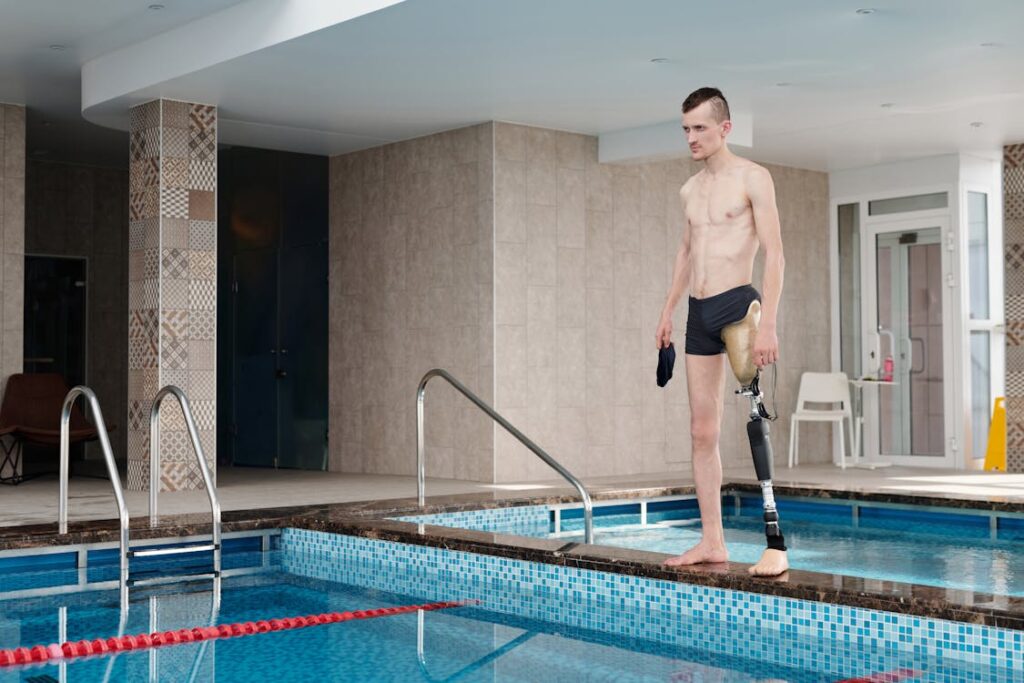
Psychological Impact of Weight-Bearing Challenges
Weight-bearing difficulties are not only physical. They affect a person’s confidence, motivation, and sense of independence.
When walking feels painful or unsteady, many people begin to withdraw from daily activities. Over time, this can have a deep emotional impact.
Confidence in Movement
For transtibial users, learning to trust their prosthetic can come fairly quickly with proper rehab. The natural knee gives them more control, which helps rebuild confidence in their steps.
Once they feel secure standing and walking, they’re more likely to explore, socialize, or return to work.
But even then, small setbacks can create hesitation. If the socket causes pain or the foot slips on uneven ground, a person may lose confidence in their ability to move freely.
This is especially true in outdoor settings or unfamiliar environments, where the risk of falling feels higher.
Transfemoral users face a steeper emotional slope. With no knee and higher energy demands, they often feel more cautious and unsure.
The idea of a misstep — a knee that doesn’t lock in time, or a sudden shift in weight — can create real anxiety. This affects how and where they choose to walk.
Over time, some people start to avoid crowded places, busy streets, or social events. Not because they don’t want to go, but because moving through those spaces feels risky or exhausting.
Fear of Falling
Falling is a serious concern. Transtibial users are less likely to fall because they have better control over their balance.
They can bend their knee to catch themselves or adjust quickly. That said, uneven terrain, wet floors, or socket discomfort can still cause unexpected slips.
Transfemoral users are at a higher risk. The artificial knee doesn’t always respond the way a natural one would. If the user misjudges timing or terrain, the knee might buckle. This kind of fall can be sudden and hard to recover from, both physically and mentally.
The fear of falling becomes a quiet barrier. It holds people back from doing what they love, like taking a walk in the park or playing with their children.
It also affects posture, gait, and overall mobility because people often stiffen their body to compensate, which can lead to muscle strain or joint pain.
Social and Emotional Well-Being
Weight-bearing challenges can also create frustration. Imagine starting each day knowing that simply standing up, walking, or climbing stairs will take more time and energy than it used to. That daily mental load builds up.
People may feel left behind when they can’t keep pace with others. They might avoid events that require long walks or standing.
They may feel embarrassed when they have to stop and rest frequently or explain why they need support. These feelings often go unspoken but they matter deeply.
The key here is support — not just physical therapy, but also emotional encouragement. Peer support groups, rehab centers, and friendly prosthetists who listen and adapt to the user’s needs play a vital role in improving the experience.
At Robobionics, we’ve seen how small changes — like a better socket fit or a quick rehab session focused on stairs — can restore confidence and reduce anxiety. People feel more in control of their body again, which makes all the difference.
Skin Health and Long-Term Wear
One of the most overlooked parts of weight-bearing is skin care. The socket is always in contact with the residual limb. Friction, heat, pressure, and sweat can all affect skin health. If the skin breaks down, walking becomes painful or even impossible until healing occurs.
Transtibial Skin Challenges
For transtibial users, pressure points are mostly on the shin, calf, and ankle area. These parts of the body are not meant to carry weight, so the skin and soft tissue are more prone to bruising or irritation.
Liners help reduce direct friction, but they must be cleaned regularly. Any dirt or moisture trapped under the liner can cause rashes or infections.
In India’s humid climate, this becomes even more of a concern. Many users benefit from breathable liners and careful hygiene routines.
Over time, the shape of the residual limb can change. Muscles may shrink, or weight gain may alter the socket fit.
These changes increase skin stress because the socket no longer distributes weight evenly. This leads to pain and sometimes open sores, which need rest and medical attention.
Transfemoral Skin Challenges
Transfemoral sockets wrap around more sensitive areas — including the groin, thigh, and sometimes part of the pelvis. These regions are harder to keep dry and cool.
Constant pressure here can cause rubbing, pinching, or heat rashes.
Because more weight is supported through this area, the skin takes on more pressure for a longer duration.
If the prosthetic isn’t aligned correctly or the socket edge cuts into soft tissue, it can cause inflammation or bruising. In some cases, people develop pressure ulcers, which are painful and slow to heal.
To prevent these problems, regular checks are important. Even if the prosthetic feels “normal,” small signs like red patches or discomfort should not be ignored. A small adjustment can prevent bigger issues later on.
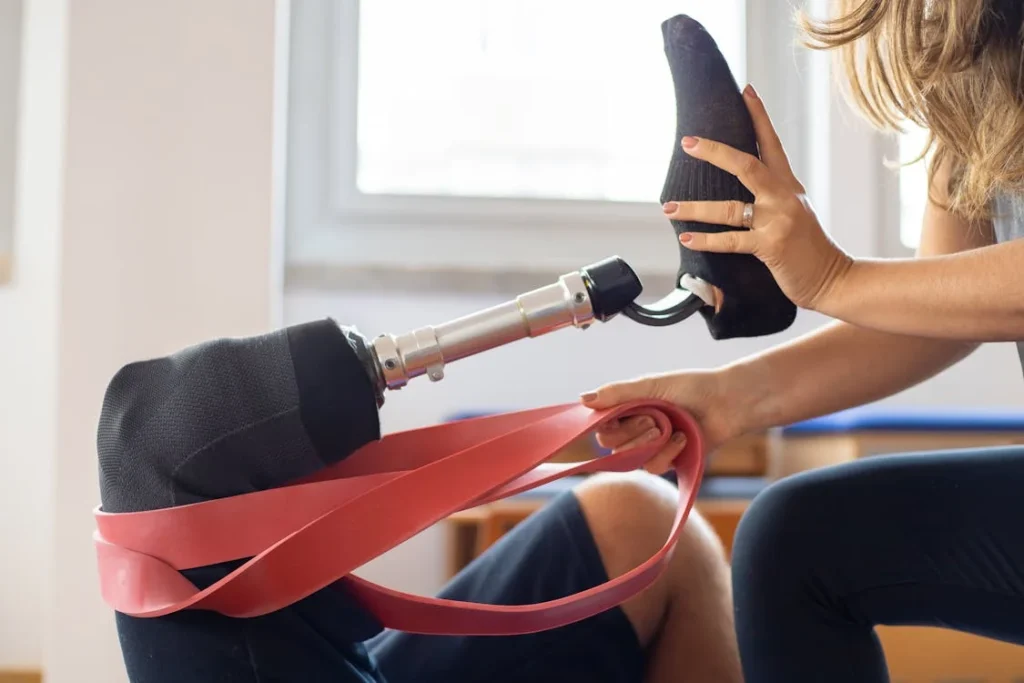
Rehabilitation and Training for Better Weight-Bearing
Walking with a prosthetic leg doesn’t come naturally. It’s a skill — one that requires time, patience, and the right kind of training.
How a person learns to bear weight on their prosthetic can shape their long-term independence and comfort. That’s why rehabilitation plays a key role in dealing with weight-bearing challenges.
The First Phase: Learning to Trust the Prosthetic
In the early days after receiving a prosthetic, most users feel unsure. Their body doesn’t yet trust the device. Even simple things like standing up from a chair or shifting weight from one foot to the other can feel strange. That’s where guided rehabilitation starts.
For transtibial users, therapy begins with basic balance and coordination. They’re taught how to stand evenly on both legs and slowly take steps while keeping their knees slightly bent.
Therapists guide users to focus on posture and muscle strength — especially in the thighs and hips, which help stabilize the body during weight shifts.
Transfemoral users often need more time. They start with standing exercises, learning to lock the artificial knee and engage their core muscles. Since they no longer have a real knee to rely on, balance training is vital.
Many users are surprised by how much work their hips and lower back need to do. Training these muscles helps reduce fatigue and gives the user more control.
This first phase is also about overcoming fear. Once a person begins to trust that the prosthetic won’t give out under them, their movements become smoother and more confident.
Gait Training and Weight Transfer Techniques
The second phase of rehab focuses on walking. This is where weight-bearing really becomes central. A natural walk involves smooth weight transfer from one leg to another, but for prosthetic users, this has to be re-learned.
Transtibial users are taught how to land gently on the heel of the prosthetic foot and roll forward naturally. Therapists work on timing and stride so the body doesn’t favor one side.
The goal is even weight distribution, which reduces joint stress and prevents long-term back or hip pain.
Transfemoral users need to learn how to activate the artificial knee with every step. Depending on the type of knee (mechanical or microprocessor-controlled), the process changes slightly.
They often learn a strategy called “hip extension,” where they use their hip to guide the knee into the correct position. This takes time and strength, but it makes walking much safer.
Another key part of gait training is muscle coordination. Many people don’t realize how many small muscles are involved in balance.
Rehab helps users reconnect with those muscles and strengthen them. When the muscles around the residual limb are stronger, they can handle more pressure without soreness.
Using Technology to Aid Rehabilitation
Modern rehab isn’t limited to the clinic. At Robobionics, we encourage gamified home-based rehab that lets users continue their training in a fun and effective way.
With simple mobile apps and motion sensors, users can play games that involve real movements — standing, stepping, and balancing — all while tracking progress.
This approach keeps people motivated. Instead of repeating dull exercises, they engage in interactive activities that stimulate both the body and brain.
Over time, this builds better habits and improves how weight is placed and distributed on the prosthetic leg.
It also gives therapists data they can use to make adjustments. If a user is putting too much pressure on one part of the socket or moving unevenly, the system can flag it. This helps solve problems early, before they lead to injury or frustration.
Retraining the Brain
There’s another side to rehab that people often miss — the brain. After an amputation, the brain still remembers the missing limb. This is called “phantom limb sensation,” and while it’s normal, it can make weight-bearing feel confusing at first.
The brain needs time to update its internal map of the body. Rehab activities that involve vision, touch, and movement help speed this process.
The more a person practices walking and standing correctly, the more the brain accepts the prosthetic as part of the body.
This is especially important for transfemoral users, who have to control more artificial components. When the brain and body start working together again, movements become faster, smoother, and more natural.
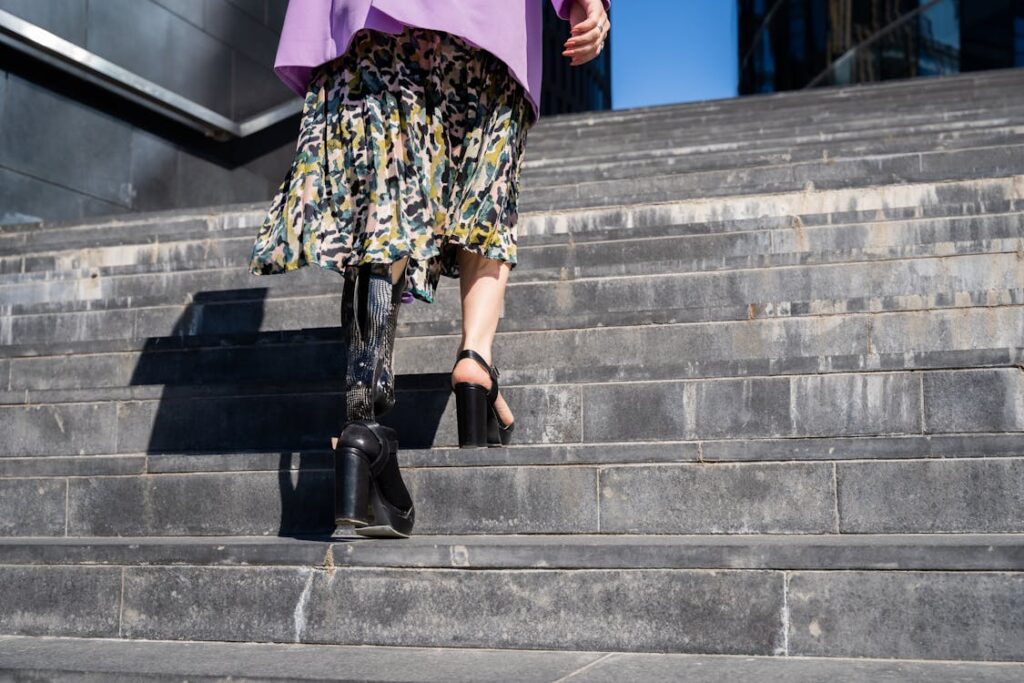
Customization and Fitting: The Foundation of Better Weight Support
Every person is unique. Their height, weight, muscle strength, and the shape of their residual limb all affect how a prosthetic should be built. That’s why there is no such thing as a one-size-fits-all prosthetic.
Custom fitting is not just about comfort — it directly affects how well the prosthetic can bear weight.
Building the Right Socket
The socket is the first and most critical component that needs to match the user’s anatomy. For transtibial users, this means designing a socket that supports the shin without pinching the bones or pressing too hard on soft tissue.
The goal is to spread pressure evenly across the residual limb so that no single spot carries all the weight.
Socket design often involves a balance between tightness and freedom. If the socket is too tight, it causes pain and restricts blood flow. If it’s too loose, the leg moves inside it and creates friction.
This can lead to blisters, bruising, or even skin breakdown. That’s why regular adjustments are often needed, especially in the first few months as the limb changes shape.
For transfemoral users, socket fitting becomes more complex. The socket must hold the upper thigh securely while allowing the person to sit, bend, and move without too much restriction.
It must also anchor the prosthetic knee in the right place. If the socket shifts even slightly during walking, it can throw off the user’s balance and increase the risk of falls.
Many transfemoral sockets use a suction or vacuum system to stay in place. These systems improve suspension and reduce unwanted movement.
However, they also require careful maintenance and hygiene to avoid skin problems. Some users may prefer belts or straps, depending on their lifestyle or body shape.
Choosing the Right Components
Weight-bearing also depends on what’s below the socket — the knee and foot units. For transtibial users, the foot plays a major role in absorbing impact and pushing the body forward.
A basic foot might be enough for someone with a slow walking speed, but active users benefit from energy-return feet, which store energy during step impact and release it as they push off.
For transfemoral users, the knee unit is the main focus. Mechanical knees are durable and lower in cost, but they require the user to walk a certain way to keep the knee stable.
Microprocessor-controlled knees adjust in real time to terrain and walking speed, making it easier to walk safely and naturally. These devices can sense when the user needs more support — like when going downstairs or walking on uneven ground — and react instantly.
The choice of knee affects how much effort a person must use during weight transfer. A poorly matched knee can make walking harder, while the right one can make movement smoother and more energy-efficient.
Alignment: The Invisible Key
Even the best prosthetic in the world won’t feel right if it’s not aligned properly. Alignment refers to how all parts of the prosthetic — socket, knee, foot — are positioned in relation to the body. If they’re even a few degrees off, the user may bear weight incorrectly, leading to pain or instability.
For example, if the foot is tilted slightly inward, the user may roll their ankle or put too much pressure on one edge of the socket. If the knee is positioned too far forward, the leg may feel unstable when stepping.
At Robobionics, we spend a lot of time fine-tuning alignment. We observe how users walk, stand, and shift their weight. We make small changes to the angles or position of the prosthetic until the movement feels smooth and stable. This process may take a few sessions, but the results are worth it.
Proper alignment reduces strain on joints, improves comfort, and allows the user to carry their weight more evenly.
Reassessment Over Time
Bodies change. Muscle mass shifts, weight goes up or down, and the residual limb evolves. That’s why fitting and alignment are never one-time tasks.
Even after a year of wearing a prosthetic, a user might need a new socket, different foot, or small adjustments to maintain comfort and good weight distribution.
This is where ongoing support comes in. At Robobionics, we encourage users to schedule regular follow-ups. These check-ins help us spot potential issues before they become serious problems.
If a user begins to favor one leg, complains of back pain, or notices red spots on their limb, it’s a sign that something needs to be adjusted.
In many cases, these changes are simple — a new liner, a small tweak to socket shape, or a different foot module. But even minor improvements can make walking and standing much easier and less tiring.
Conclusion
Weight-bearing challenges in transfemoral and transtibial prosthetics are complex, but they’re also manageable with the right knowledge, care, and support. While transtibial users benefit from having a natural knee to assist with movement and stability, transfemoral users face added demands due to the loss of that joint. Every step, from socket design to rehabilitation, plays a critical role in improving comfort, balance, and independence.
At Robobionics, we believe that a prosthetic should feel like a part of you — not a burden. Through careful customization, ongoing support, and innovative rehab solutions, we help individuals move with more ease and confidence, no matter the level of amputation.
If you or a loved one is navigating life with a prosthetic, know that you’re not alone. With the right tools and guidance, every step forward becomes a little easier.



